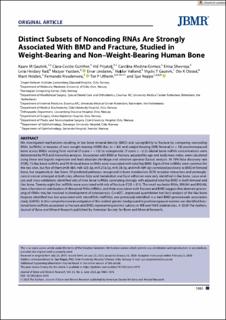| dc.description.abstract | We investigated mechanisms resulting in low bone mineral density (BMD) and susceptibility to fracture by comparing noncoding RNAs (ncRNAs) in biopsies of non–weight‐bearing (NWB) iliac (n = 84) and weight bearing (WB) femoral (n = 18) postmenopausal bone across BMDs varying from normal (T‐score > −1.0) to osteoporotic (T‐score ≤ −2.5). Global bone ncRNA concentrations were determined by PCR and microchip analyses. Association with BMD or fracture, adjusted by age and body mass index, were calculated using linear and logistic regression and least absolute shrinkage and selection operator (Lasso) analysis. At 10% false discovery rate (FDR), 75 iliac bone ncRNAs and 94 femoral bone ncRNAs were associated with total hip BMD. Eight of the ncRNAs were common for the two sites, but five of them (miR‐484, miR‐328‐3p, miR‐27a‐5p, miR‐28‐3p, and miR‐409‐3p) correlated positively to BMD in femoral bone, but negatively in iliac bone. Of predicted pathways recognized in bone metabolism, ECM‐receptor interaction and proteoglycans in cancer emerged at both sites, whereas fatty acid metabolism and focal adhesion were only identified in iliac bone. Lasso analysis and cross‐validations identified sets of nine bone ncRNAs correlating strongly with adjusted total hip BMD in both femoral and iliac bone. Twenty‐eight iliac ncRNAs were associated with risk of fracture (FDR < 0.1). The small nucleolar RNAs, RNU44 and RNU48, have a function in stabilization of ribosomal RNAs (rRNAs), and their association with fracture and BMD suggest that aberrant processing of rRNAs may be involved in development of osteoporosis. Cis‐eQTL (expressed quantitative trait loci) analysis of the iliac bone biopsies identified two loci associated with microRNAs (miRNAs), one previously identified in a heel‐BMD genomewide association study (GWAS). In this comprehensive investigation of the skeletal genetic background in postmenopausal women, we identified functional bone ncRNAs associated to fracture and BMD, representing distinct subsets in WB and NWB skeletal sites. | |
